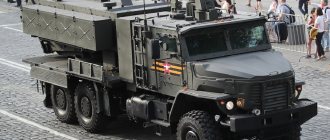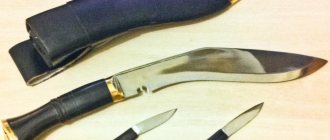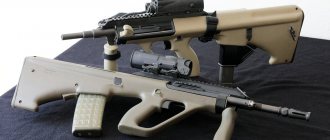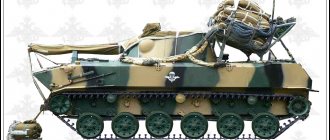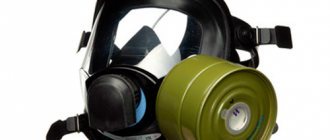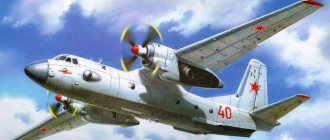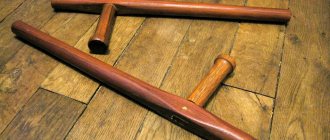The category of military engineering equipment includes a number of specialized weapons, including active standoff units, mobile transport mechanisms for operation and repair, and electrical modifications for combined arms. These units are focused on performing engineering course tasks during reconnaissance, combat or defense support. The vehicles are in service with units of engineering battalions and a number of other military units.
IRM-2
This unit of Russian military engineering equipment is intended for reconnaissance operations and determining routes for the movement of troops with the possibility of crossing water obstacles. This vehicle is equipped with stationary and mobile reconnaissance devices, which make it possible to obtain information about the number of enemy units being moved, the presence of mines and other obstacles, as well as the level of contamination of the territory.
Regarding water obstacles, information is provided in the following format:
- width and depth parameters;
- flow intensity;
- presence of navigation oppositions;
- data on the technological capabilities of existing bridges.
The speed for reconnaissance operations is 10 km/h, for detecting explosive and mine obstacles - 5 km/h, and determining the characteristics of water obstacles up to 100 meters wide - about five minutes.
The design of the IRM-2 vehicle was developed on an armored track base using components and parts of the BMP-1. The UTD-20 power unit is a six-cylinder diesel engine with a power of 220 kW, which guarantees high maneuverability of the equipment. The speed limit on land is 50 km/h, on water – 10-12 km/h.
Engineering Troops: What new military equipment will enter the army
Chairman of the Military Scientific Committee of the Engineering Troops Maxim Krivosheev spoke about the new military equipment that will be supplied to the army, as well as how engineering equipment is being improved taking into account the Syrian experience.
Maxim Vladimirovich, the Engineering Troops are currently developing an installation for producing water from snow and ice, UPPVS-5. The supply of such specialized equipment is due to the fact that with the development of the Arctic region we are faced with the problem of drinking water?
Maxim Krivosheev: This is the main reason. Yes, now the engineering troops have become more actively involved in carrying out tasks in the Arctic zone. The group expanded there. Challenges arose to provide people with drinking water. Of course, we used to have similar installations in our supply, but with much lower productivity. We are now working on creating a new installation, which will be more than five times superior to current cleaning products in terms of characteristics. However, UPVS-5 will remain mobile; it can be delivered to the task site in a short time, deployed and begin receiving water.
How will the installation work? A car is being driven up, soldiers with shovels are throwing snow into it...
Maxim Krivosheev: Simplified - yes. The unit can be transported on any vehicle. This is a container that is unloaded from the car and, as they say, from the wheels, ready to work. UPPVS-5 includes a power plant that ensures the operation of the melting element of the installation. There is also a water purification system there, because snow is not impeccably clean even in the North. In addition, water obtained from snow is melt water. It is demineralized, which means it cannot be consumed constantly so as not to wash calcium out of the body. Therefore, there is a product that saturates the water with the necessary minerals so that the water becomes potable and suitable for consumption by personnel.
When will it be put into service?
Maxim Krivosheev: The prototype is currently being assembled. We are starting to conduct factory tests. After this, State tests will begin. We expect to complete the development of this tool by the end of the year.
Now probably the most pressing topic is the introduction of robotic systems. What is being created on this topic for the engineering troops?
Maxim Krivosheev: The work of engineering troops, especially mine clearance, is associated with danger for personnel. To minimize such risks, robotic tools have already been created that make work easier during mine clearance. Currently, development work is being carried out to create multifunctional robotic assault and barrage complexes IMRTK-ShR, and a heavy-class robotic demining complex IMRTK-RT. Work is underway on small robotic systems.
Can you tell us more about the robotic systems for the assault and barrage battalions, or, as they are also called, engineering special forces?
Maxim Krivosheev: Currently, development work is being carried out on this complex. Documentation is being developed. It hasn't gotten to the point of testing yet.
What is included in it first? Is he specifically for those guys who storm buildings, and he goes ahead and covers them?
Maxim Krivosheev: Yes. The stormtroopers are hiding behind him, covering themselves. He will have a blade in front, which will allow him to break through some rubble in destroyed structures, he will have a means of fire support for attack aircraft, and there will be a universal bulldozer, which is designed for clearing rubble or making breaks in the walls of a building. That is, that set of equipment that will allow you to complete the task of storming buildings with the least cost and losses. They can be used to breach walls so that stormtroopers can enter a building from any direction, regardless of whether there are doors there. It is completely uninhabited. Unmanned. Operator controlled.
Now almost all military equipment has been tested in Syria. Tell us about the samples of engineering equipment that did this?
Maxim Krivosheev: Our units tested the equipment during actual combat missions. It's a good way to try out the tools we have. Every time the demining squad went out, we sent promising and prototypes along with it. First of all, engineering reconnaissance equipment, various mine detectors, subsurface detectors, ground penetrating radars, and bomb detectors were exported to Syria. Everything that we now have new in the troops has been tested during the execution of tasks in the Syrian campaign. Based on the results of these tests, even those tools that are already in service were improved. For example, the PPO-2 subsurface detectors were tested. A number of shortcomings were identified, we listened to comments and suggestions from people who directly exploited them. This was all taken into account and tested during state tests. The already modified product has been accepted for supply.
Robotic systems were actively tested. The same Uran-6. Based on the results of work carried out in Syria, changes were made to its design. In particular, the location of the cameras has been changed, anti-fragmentation protection and dust protection have been enhanced. For example, additional seals and a filtration system are installed. And so on for each sample.
In Syria, you often have to deal with a large number of tunnels, underground passages that stretch for many kilometers. How to explore and clear these tunnels? What difficulties do sappers face?
Maxim Krivosheev: While working in Syria, a large number of tunnels were identified that were used by militants both for movement and for storing weapons and ammunition. Various countertunnel countermeasures have been developed. This includes digging ditches to identify and prevent undermining under the protected area. The engineering troops identify such tunnels during engineering reconnaissance. To identify tunnels, in Syria we used ground penetrating radars, which allow us to detect voids in the ground at great depths. We have not used such means before. With the help of these devices you can find out whether there is a tunnel, a tunnel or something else. After that, measures are taken to open this tunnel and destroy it. Conducting direct demining work in a confined space is a difficult task. Where humans cannot work, mine detection dogs are used, trained to work in such areas. In order to work in absolute darkness, the demining kit includes sufficiently powerful flashlights attached to the helmets, which allow illumination of the work area in dark basements. Basically, dogs are used where humans cannot pass. They bring great benefits.
Another new product has appeared in the army - radar simulators of a moving column. Can you tell me how they work?
Maxim Krivosheev: Now reconnaissance equipment uses the most modern methods to detect moving equipment. There was a need to create tools that simulate the signal of moving equipment. And these means are placed at a certain distance from each other and can simulate the movement of a column.
How does it work? A column of equipment consists of tanks, infantry fighting vehicles, trucks, how can they be replaced with a device?
Maxim Krivosheev: Each piece of equipment has its own radar portrait. This portrait is emitted at a specific wavelength when enemy reconnaissance equipment is used. And they use their surveillance equipment, radar equipment, to detect such emissions. That is, they do not visually see the movement of the column, but a signal is received on the radars.
Well, that is, a reconnaissance plane is flying...
Maxim Krivosheev: Yes. It records the movement of a convoy of equipment, but in fact it uses radar simulators. In this way we mislead the enemy. The simulator is a not very large device, mounted on tripods. A fairly compact tool that can be deployed by a small unit. Each element is worn by hand. And from a small, two-kilowatt power plant, all this is powered and placed in the desired area.
More recently, the troops began to receive engineering and reconnaissance boats; are they being supplied for testing or have they already gone into production?
Maxim Krivosheev: Yes, the troops already have them, in small quantities, but they are already arriving. State tests of such boats have been completed. The documentation has been approved. They are now being accepted for supply. So far, the troops have received five such boats. This is a completely new model for us. Previously, such technology simply did not exist. I don’t know who in the armed forces currently has small hovercraft with such a wide range of functionality. This includes intelligence, which is provided by various means. These are heading and side sonar, echo sounders that allow you to profile the bottom - profilographs. The boat has passed and can determine in real time the nature of the water obstacle, speed, current, depth, nature of the bottom, off the coast. It easily comes ashore, swampy, sandy, hard. It doesn't matter to him where to go. The air cushion allows you to do this. And in real time everything is transmitted to a higher commander. It is immediately clear what that water barrier is, where it can be crossed, and what kind of crossing can be equipped.
Where will these boats be delivered?
Maxim Krivosheev: To the engineering reconnaissance units, pontoon-bridge units.
Military scientific committees also deal with forecasting issues. It’s probably not easy to look ten, fifteen years into the future and understand how the development of the troops will proceed. Are there any promising developments that will appear not tomorrow, not the day after tomorrow, but in, say, five years?
Maxim Krivosheev: The Military Scientific Committee of the Engineering Troops, the Central Research Testing Institute of the Engineering Troops is conducting an in-depth analysis of the development of promising weapons. Including the enemy. An analysis is being carried out to see in which direction they are going and in which direction we are going. An analysis of the implementation of engineering support tasks by various departments is carried out. Military science specialists participate in almost all operations and tasks performed by the engineering troops, the results of which are used to carry out an in-depth analysis that makes it possible to identify problems in one direction or another. And adjust our plans accordingly.
Stationary devices
The category of static devices of military engineering equipment includes a mine detector with a wide grip (RShM-2). It is focused on searching for anti-tank and anti-personnel mines with a metal casing. Detection of ammunition is carried out both on land and on water.
Another stationary type device is a reconnaissance echolocator (ER). The device is used to record the bottom profile and other features of the liquid barrier, the degree of soil density and find navigation obstacles with subsequent fixation on electrothermal paper. The fluctuation of depth meters is from 0.5 to 20 meters.
Training of military engineers
Officer training is carried out by the Combined Arms Academy of the RF Armed Forces (Moscow) and its branch - the Tyumen Higher Military Engineering Command School named after Marshal A.I. Proshlyakova. Junior specialists are trained by the 187th Pskov Order of the Red Star and the 210th Guards Kovel Red Banner interspecific regional training centers (the latter is located in the Nizhny Novgorod region).
Russian mine clearance specialists are trained by the 66th Interdepartmental Methodological Training Center. In August 2014, a special unit was formed for foreigners - the International Mine Action Center (IAC) of the Russian Armed Forces in Nakhabino, near Moscow. The center's military personnel participate in humanitarian mine clearance operations outside the country.
In January of this year, the Eastern Military District began forming and training consolidated flood control groups, which in the spring will help protect populated areas of the Far Eastern Federal District.
Portable devices
Portable units of military engineering equipment of the USSR and Russia include PAB-2AM (compass equipment), mine detectors such as RVM and IMP, and a standard reconnaissance periscope. This category also includes:
- sapper action rangefinder DSP-30;
- penetrometer of mechanical configuration RP-1;
- device for studying bridges KRM;
- demining kit KR-O;
- ruler-ice meter.
The IRM vehicle is equipped with various mechanisms that allow it to observe the terrain day and night with simultaneous orientation. This includes:
- retractable panoramic periscope PIR-451;
- TVN-2BM night tracking device;
- AGI-S slope angle determinant "artificial horizon";
- personal surveillance devices of TNGOs;
- tank navigators TNA-3;
- TDA integrated defense and camouflage system, water drainage pump.
- communication devices;
- armament - PKG course machine gun mount.
Goals and current status
Modern engineering troops of the RF Armed Forces:
- carry out tasks of engineering reconnaissance, construction of trenches, trenches, shelters, anti-tank ditches;
- lay minefields and engage in mine clearance, carry out blasting operations;
- equip crossings on water obstacles, extract and purify water in the field;
- carry out work on camouflage, imitation of troops and objects.
In peacetime, these units clear the area of explosive objects, participate in eliminating the consequences of man-made accidents, catastrophes and natural disasters, and prevent the destruction of bridges and hydraulic structures during ice drifts.
Tactical exercises of the motorized rifle brigade and engineering units of the 5th Army
Image source: © Yuri Smityuk/TASS
Separate engineering brigades are part of the Western, Southern, Central and Eastern military districts; naval engineering battalions - part of the Northern and Pacific fleets of the Navy. The Black Sea and Baltic Fleets have separate naval engineering regiments. Also, a similar regiment was created to support fleet operations in the Arctic. By 2022, engineer-sapper and pontoon-bridge brigades are planned to be created in each combined arms army.
Chief of the Engineering Troops - Lieutenant General Yuri Stavitsky (since July 2010).
KRV kit
Soviet military engineering equipment includes in its list an aerographic and aerovisual reconnaissance system. Thanks to this device, liquid barriers are detected by moving units, mines and other obstacles, including ground processing of intelligence data and quality control of camouflage of combat units.
Modifications of the KRV are transported on a body van of the 131st ZIL. The kit includes a camera, binoculars, an optical sight, an anti-aircraft tube, a voice recorder and a commander's fuel tank. Air reconnaissance on the MI-8 is carried out using AFA and FS aerial cameras. The use of this unit of military engineering equipment allows for routine surveying at speeds of up to 170-180 km/h. The inspection depth is up to 15 kilometers when the aircraft is 2-5 km away from the forefront of events.
Knife trawls
The military engineering equipment, the photo of which is given below, refers to standard KMT-type knife trawls. The machines operate on the principle of digging devices and are structurally made in the form of a blade with cutting parts of a cutting configuration.
Track-roller modifications are equipped with knife and special compartments. Their weight activates the fuses of the anti-tank pressure mines. Electromagnetic mine sweeping devices (EMT) can be mounted on tanks with any type of fastenings.
UR-77
The military equipment of the engineering troops in this design is aimed at making tunnels through minefields using an explosive method. The base is a multi-purpose tractor on MTL tracks. The equipment guarantees the supply of charge for 200-500 meters, resulting in the formation of a “clearing” 6 m wide and 90 m deep. The weight of the machine is 15.5 tons, speed indicators are 60/5 km/h (on land/in water).
Below are the labor intensity and repair standards for military engineering equipment of the cost center type:
- Remote mining makes it difficult for the enemy to detect ammunition.
- Devices for mechanized mine placement are divided into several groups (ground minelayers, helicopter equipment, remote mining systems such as VSM and ASM).
Oh, roads!
In the mid-1930s, after special tests, various samples of road and construction machines were selected for engineering units. In 1937–1938 the experience of their operation in military units made it possible to adopt special equipment modified for the army: the heavy GTM grader and the BG-M bulldozer, the SP and ST-5 scrapers, the KV-2 and KV-3 double-blade ditch diggers, the heavy collapsible ripper (ripper), as well as a powerful special LNG grader and a wheeled motor grader with a pick operator.
One of the first mobile charging and lighting power stations to appear in engineering units was AES-1 (in 1930, power 3 kW on a Ford AA chassis) and AES-3 (in 1935, power 15 kW on a GAZ-AA chassis). Deliveries of water treatment stations ASF-500, drilling rigs AVB-100 (on ZIS-5 or ZIS-6 chassis), field aircraft repair shops PARM-1 and field workshops of the APRIM engineering troops have begun. Three-axle ZIS-6 served as the basis for truck cranes AKE, AK-3 and AKM plants named after. January Uprising and “Red Metalist”, automobile power plants AES-4 and self-propelled compressor stations SKS-36 to power mobile pneumatic hammers and coastal pile drivers.
Anti-aircraft searchlight installations (stations) became increasingly widespread. The O-15-3 searchlight station was produced on the ZIS-5 chassis, and the PO-15-8 searchlight station on the ZIS-6 chassis. From 1938 to 1942, long-wheelbase ZIS-12 with low sides became widespread to install the Z-15-14 anti-aircraft searchlight system.
However, the main means of mechanization of work before the Great Patriotic War in engineering units remained tracked and wheeled tractors. Moreover, until the first half of the 1930s, the basis of the fleet in the national economy and the Red Army were foreign vehicles. During the period 1922–1930 Over 60 thousand tractors were imported into the USSR, while no more than 17 thousand were produced at all factories. With the development of the production of tracked tractors, the share of domestic equipment significantly outweighed imports.
Tracked minelayer
Among the abandoned engineering military equipment of the Soviet Union there is such a representative as GMZ-3, which was intended for mechanized deployment of anti-tank mines of the TM configuration, equipped with contact and non-contact types of fuses.
The vehicle was equipped with equipment for monitoring minefields, armor protection and a PKT machine gun mount. The power unit was a 12-cylinder diesel engine with a capacity of 520 horsepower. The weight of the unit is 28.5 tons, the speed when installing mines in the ground/on the surface is 10/16 km/h. Crew: three people.
Beginning of motorization
By the beginning of the twentieth century, mechanization was used only in military road construction, where the main contractor was the Ministry of Railways. The first self-propelled steam rollers arrived at the Ministry of Railways back in the second half of the 19th century. By 1990, they were supplied by Simeon & Porter, Aveling & Porter, Fowler, Marshall, and Albare. Then the fleet was replenished with machines from the Mechanical, Bryansk Machine-Building Plant, Warsaw, Kolomna Machine-Building Plant, Mechanical and Iron Foundry in Bialystok and the Votkinsk State Plant. At the same time, artillery units of the Russian army were actively supplied with steam routers and tractors.
As soon as cars became an integral technical means of the armed forces, wheeled vehicles began to be used in engineering. During the III International Automobile Exhibition in May 1910, the Main Engineering Directorate of the Russian Imperial Army tested 16 trucks and 2 tractors with trailed carts on the highway between St. Petersburg and Moscow. The commission's findings on the use of mechanical transport for the transport of heavy loads were positive. However, large-scale equipment of engineering units with cars began only in 1914, and they were used mainly for transporting building materials.
By 1917, in terms of motorization of troops and mechanization, the Russian army looked quite respectable among the leading powers. Moreover, in the First World War, the engineering units of Austria-Hungary and Germany looked more than modest compared to the equipment of the Entente.
Trench and pit units
Wheeled TMCs and tracked BTMs are used to excavate trenches using a rotary working element. It allows you to excavate soil to a depth of up to 1.5 meters, and the outline can be straight or curved. The dump is carried out in two directions, the width of the finished trench is 0.5/1.1 meters (along the bottom/top). Some modifications are equipped with bulldozer mechanisms that serve to fill craters, ditches, and tear off trenches.
Excavation engineering equipment is aimed at excavating sites for fortification structures and special shelters for combat and auxiliary units. The standard design of the machines under consideration consists of a track tractor, a milling working element, and additional equipment. For example, the MDK-3 machine is equipped with a ripper, which makes it possible to cultivate frozen and hard soil to a depth of 30 centimeters.
Kings of Nature
Big tasks required big machines, and after the war they did not fail to appear. AT-T high-energy tracked transporters, produced in 1949–1979. at the Kharkov Transport Engineering Plant, became the basis for a large range of high-performance machines. Extended product 426U for establishing crossings, installing power plants and beams, product 409U and 405MU for trench BTM and BTM-3, excavation MDK-2, track-laying equipment BAT and many other earthmoving and excavation tools with active and passive working parts.
It is generally accepted that tracked vehicles are mainly used as carriers of earthmoving units, but it is necessary to include motor graders, scrapers, earth carriers and engineering tractors. For example, TMK, based on the IKT engineering wheeled tractor (MAZ-538), installed a rotary working body for trenching and bulldozer equipment. Trench removal in thawed soils at a depth of 1.5 m was carried out at a speed of 700 m/h, in frozen soils - 210 m/h. Passive-type slopes were installed on the frame of the working body, ensuring the formation of inclined walls of the trench. The RK2, PKT-2, I-400 vehicles were manufactured on the KZKT-538DK, KZKT-538DN and KZKT-538DP chassis.
Gigantomania in the engineering troops is associated not only with the need to have highly productive and energy-rich units, but they are also a means of covering up large equipment. For example, the modern "Agregat 15M69 MIOM" - an engineering support and camouflage vehicle on the MZKT-7930 "Astrologer" chassis - today serves in the engineering units of the Strategic Missile Forces. If the missile carriers were smaller, the camouflage vehicles would not be so large.
Other military engineering equipment
The PZM-2 earthmoving machine is used for making trench and foundation pit structures. The working mechanisms are based on a wheeled tractor with a rotary thrower, a traction winch and a bulldozer blade. This category also includes military excavators designed for loading and digging work when equipping military positions and management posts.
Design of a military excavator:
- base chassis in the form of a car with increased cross-country ability;
- frame frame with external support elements;
- power unit;
- excavator attachments;
- rotating platform;
- hydraulic drive;
- hook suspension;
- backhoe.
Tracklayers of the BAT configuration are designed to maintain and prepare routes for maneuvers and movement of military units. These machines, along with the universal analogues of UDM and BKT, are also aimed at arranging exits from bridges, crossings, overcoming ravines and other ground obstacles.
Bulldozers in armor
One of the main units of the engineering troops is the pontoon-bridge brigade. Their task is to guide equipment and personnel where, as they say, you can’t get through without their help. Destroyed buildings, artificial enemy obstacles, natural and landscape features, or bodies of water can hinder the advance of troops. Engineers will handle all this with the help of special equipment.
Armored engineering vehicles based on the B10M2 and B12 tractors and the PK-55S front wheel loader with special protection are produced by the Chelyabinsk Tractor Plant (part of UVZ). These vehicles make it possible to effectively clear debris and pave the way during combat operations. The main elements of the equipment are protected by armor, a high percentage of parts are unified with parts of civilian models of the plant.
Engineering clearing vehicle IMR-3M. Photo: Ministry of Defense
The IMR-3M engineering clearing vehicle produced by UVZ is a real “terminator” of the engineering troops. Operating on the chassis of the T-90 tank, the vehicle is equipped with a universal bulldozer blade and a telescopic boom with a manipulator. IMR-3M can make passages in rocky and forest rubble, in snowdrifts and minefields, dig or fill pits. The crew is able to work even in radiation conditions, and for self-defense the vehicle is equipped with a machine gun.
One of UVZ’s promising developments in this direction is the UBIM universal armored engineering vehicle. It combines the capabilities of three engineering units at once - an armored repair and recovery vehicle, an engineering clearance vehicle and an armored mine clearing vehicle. This armored monster can work under heavy enemy fire and pave the way for troops even through territory where weapons of mass destruction were used.
